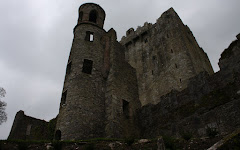 A view from above of "my" beach, the marina beach, the closest coastal area to my home (about a 3-minute walk from my house).
A view from above of "my" beach, the marina beach, the closest coastal area to my home (about a 3-minute walk from my house). The swimming beach, a 10-15 minute walk from my house. (On a clear day you would be able to see Mt. Fuji on the horizon above the sea.)
The swimming beach, a 10-15 minute walk from my house. (On a clear day you would be able to see Mt. Fuji on the horizon above the sea.)With only a week and a half of official summertime freedom spent in Japan--oh yes, school for me begins on Wednesday--the record of my history here this summer is a notably briefer tome to synthesize and summarize than are my summer experiences in other places, and so bulleted notes should suffice:
- The air has weight and instantly drapes you in a clinging wet warmth; you can feel your passage through the atmosphere.
- Cloaked in leafy treetops, cicadas squeal and moan ecstatically through the sultry day-lit hours; from their shadowed corners and dark places, crickets chirp the night lullabies of dwindling summer.
- Although three seriously shaker quakes--all 6+ range on the Richter Scale--rocked the Tokyo area in the five days before my return to the Land of the Rising Sun, the four tectonic plates meeting below this land seem to have settled a bit. (BIG sigh of relief from me!) I have experienced only one noticeable, but little, tremble in the last week.

- Hill runs have switched out with the track work on the running plan. My neighborhood here provides multiple hill courses but no place to encourage any sort of engagement with high stepping, backwards running, etc. The base has two tracks I can use once I move some of my runs to that location.
- One morning I saw the three runners--a man with two teens--I cross runs with every fall, usually on Saturday mornings. Of course, this time it was still summer and a week day morning too. The man does the nod and the "ohayo goziamasu" (good morning), the boy nods, the girl smiles. I have never been able to decide if the man is the father or the coach. When I first started seeing them running together, the kids were middle school age. Not any more--most certainly high school now! And now I'm thinking maybe the man is the father and the kids are brother and sister; the kids show this rather detached boredom towards each other--definitely no romantic chemistry or even interest--it's all just a running thing for them!
- I have abandoned skating, really not a viable option in my Japanese neighborhood, for walking on the alternate mornings I don't run. In the course of my ramblings I have discovered a vending machine that sells Coke Zero for 10 yen (11-12 cents) cheaper than all the other vending machines in the area, a small cove between the marina beach and the swimming beach where Japanese beach-dude types hang in neo-hippie ambiance, and election posters everywhere, one with a guy running on the ticket for the "bring happiness party." (Okay, I can't remember if that's the exact translation printed in small Roman alphabet letters below all the Japanese, but it was something very similar. Talk about a different culture! Can you imagine how long a political party in the USA with that name would survive?)








































































